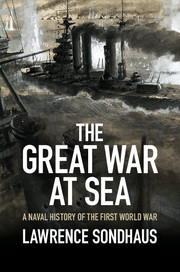Book contents
- Frontmatter
- Contents
- List of figures
- List of maps
- Acknowledgments
- Introduction
- 1 Ambition, ideology, and arms races
- 2 Preparing for war
- 3 Global prelude
- 4 European waters, 1914–15
- 5 Submarine warfare: The great experiment, 1915
- 6 Combined operations, 1915
- 7 The year of Jutland: Germany’s fleet sorties, 1916
- 8 Submarine warfare: The great gamble, 1917–18
- 9 War and revolution, 1917
- 10 Final operations
- Conclusion: Peace and naval disarmament
- Bibliography
- Index
- References
6 - Combined operations, 1915
Published online by Cambridge University Press: 05 August 2014
- Frontmatter
- Contents
- List of figures
- List of maps
- Acknowledgments
- Introduction
- 1 Ambition, ideology, and arms races
- 2 Preparing for war
- 3 Global prelude
- 4 European waters, 1914–15
- 5 Submarine warfare: The great experiment, 1915
- 6 Combined operations, 1915
- 7 The year of Jutland: Germany’s fleet sorties, 1916
- 8 Submarine warfare: The great gamble, 1917–18
- 9 War and revolution, 1917
- 10 Final operations
- Conclusion: Peace and naval disarmament
- Bibliography
- Index
- References
Summary
“We are going to get through,” confided Commodore Sir Roger Keyes to his diary, ten days before the Allied fleet he helped direct made its ill-fated attempt to force the Dardanelles, “but it is a much bigger thing than the Admiralty or anyone out here realized.” Keyes served as chief of staff to Vice Admiral Carden, commander of the reinforced British Eastern Mediterranean Squadron, tasked with opening the Turkish straits to the Allies, in the hope that by threatening Constantinople the Ottoman Empire could be forced out of the war. The following evening Carden sent the Admiralty a clear assessment of the “much bigger thing” and the challenges he faced: “The methodical reduction of the forts is not feasible, without expenditure of ammunition out of all proportion to that available…We are for the present checked by absence of efficient air reconnaissance, the necessity of clearing the minefield, and the presence of a large number of movable howitzers on both sides of the straits, whose positions up to the present we have not been able to locate.”
On March 18, 1915, the combination of formidable forts, minefields, and mobile batteries foiled the Allied attempt to force the Dardanelles using naval power alone, much to the dismay of the First Lord of the Admiralty, Winston Churchill, who had been promoting the attack for several months, all the while insisting that no troops would be needed in the assault and relatively few would be needed to secure the Gallipoli Peninsula once the fleet had taken the straits. But troops would be needed, and a great many of them, to take the Turkish forts on the peninsula that commanded the Dardanelles. Five months later, as the first great Eastern front offensive of the Central Powers was winding down, the Germans faced a similar challenge in their quest to take Riga, the largest port in Russia’s Baltic provinces. In contrast to the Dardanelles, at Riga it was the army that had assumed that it could achieve the objective with little help from the navy, only to realize that ships would be needed, and a great many of them, to secure the Gulf of Riga and force the Russians out of the city.
- Type
- Chapter
- Information
- The Great War at SeaA Naval History of the First World War, pp. 171 - 203Publisher: Cambridge University PressPrint publication year: 2014



